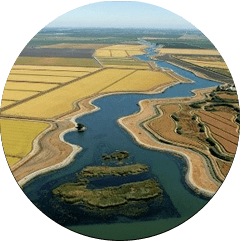Delta Conveyance Project
The Delta Conveyance Project (DCP), previously known as the California WaterFix, is an initiative designed to upgrade and safeguard California’s aging water delivery infrastructure originating in Northern California. This system, primarily sourced from the Sierra Nevada Mountains, delivers water to 27 million people through the Sacramento-San Joaquin Delta (Delta). The Delta’s network of channels is maintained by earthen levees, which are highly susceptible to damage from floods and earthquakes. Experts have warned that a disaster in this area could disrupt water supplies for millions, potentially for extended periods, which would result in significant economic impacts.
Over the years, modifications to the Delta to support agriculture, transportation, commerce, and residential development have adversely affected the local ecosystems and altered the natural environment. The current water pumping setup often causes rivers to flow in reverse, disorienting fish and drawing them away from their natural migration paths. Moreover, during intense winter storms, outdated infrastructure leads to substantial water loss to the ocean.
The project, initially championed by former Governor Edmund G. Brown, involved the construction of two tunnels and was selected after nearly a decade of comprehensive review and substantial public input. However, Governor Gavin Newsom, upon taking office, paused this plan and introduced his California Water Resilience Portfolio, which includes a revised approach featuring a single, smaller tunnel. This new phase of the project, supported by a diverse group of stakeholders, including scientists, engineers, and conservationists, employs innovative construction techniques and improved fish screens. Positioned 150 feet underground with advanced seismic design, the tunnel aims to enhance the reliability of water supplies and increase the state’s capacity to store and manage water effectively for future needs.
The Delta Conveyance Project (DCP) is currently in a crucial phase of permitting and regulatory approvals. The project’s final Environmental Impact Report (EIR) has been certified, and the project itself was approved by the Department of Water Resources (DWR), marking significant progress in its development.
Environmental and regulatory compliance is ongoing. The DWR has completed informal consultations with state and federal wildlife agencies and submitted applications for necessary environmental permits. The issuance of these permits, expected in early 2025, will address the impacts on threatened and endangered species.
Additionally, the DWR has requested a change in the points of water diversion in the northern Delta, which is critical for the DCP. This petition is under review, and a water rights hearing is expected to begin after environmental compliance processes conclude. A decision is anticipated by 2026.
The project also includes a significant community engagement component, with $200 million set aside for local community projects as part of its environmental mitigation and community benefits program.



Robert R. McVicker MWDOC Board President